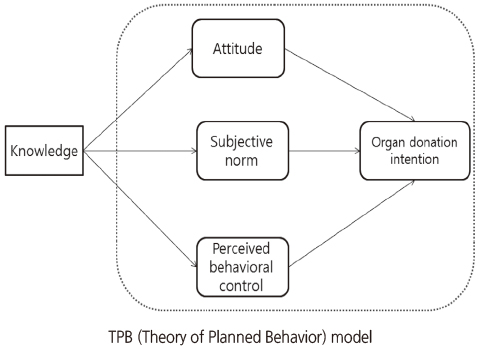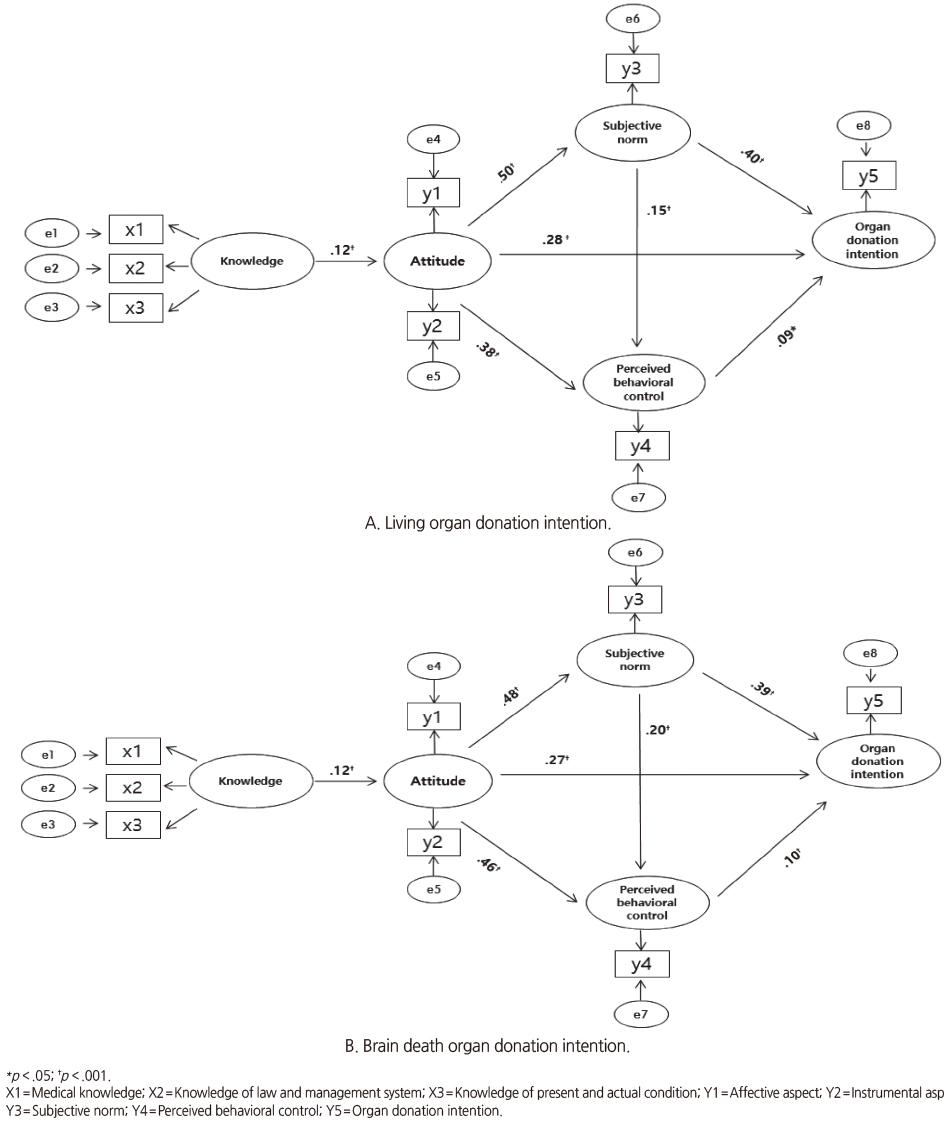J Korean Acad Nurs.
2015 Dec;45(6):802-811. 10.4040/jkan.2015.45.6.802.
Structural Equation Modeling on Living and Brain Death Organ Donation Intention in Nursing Students
- Affiliations
-
- 1Department of Nursing, Honam University, Gwangju, Korea.
- 2Department of Nursing, Mokpo National University, Muan, Korea. seami@mokpo.ac.kr
- KMID: 2363104
- DOI: http://doi.org/10.4040/jkan.2015.45.6.802
Abstract
- PURPOSE
The purpose of this study was to test and validate a model to predict living and brain death organ donation intention in nursing students. The conceptual model was based on the theory planned behavior.
METHODS
Quota sampling methodology was used to recruit 921 nursing students from all over the country and data collection was done from October 1 to December 20, 2013.
RESULTS
The model fit indices for the hypothetical model were suitable for the recommended level. Knowledge, attitude, subjective norm and perceived behavioral control explained 40.2% and 40.1% respectively for both living and brain death organ donation intention. Subjective norm was the most direct influential factor for organ donation intention. Knowledge had significant direct effect on attitude and indirect effect on subjective norm and perceived behavioral control. These effects were higher in brain death organ donation intention than in living donation intention.
CONCLUSION
The overall findings of this study suggest the need to develop systematic education programs to increases knowledge about brain death organ donation. The development, application, and evaluation of intervention programs are required to improve subjective norm.
Keyword
MeSH Terms
Figure
Reference
-
1. Kim D. A study on the factors affecting people's attitude toward organ donation. Health Soc Welf Rev. 2003; 12:96–135.2. Cha DP. Factors affecting the college students' intentions to resister and discuss the decision of organ donation with their family in situations of living, brain death, and heart death: Using an extended theory of planned behavior. Advert Res. 2010; 87:7–40.3. Korean Network for Organ Sharing. Annual report of the transplant 2013 [Internet]. Seoul: Author;2014. cited 2015 January 20. Available from: https://www.konos.go.kr/konosis/common/bizlogic.jsp.4. You HR. A study on knowledge and attitude of intensive care unit nurses regarding brain dead organ transplantation [master's thesis]. Seoul: Sungkyungkwan University;2004.5. Lee JA, Kim SY. The knowledge and attitude of medical students towards the organ donation. J Korean Soc Transplant. 2008; 22(1):120–129.6. Shon YH, Cho CM. Public's attitude to organ transplants and factors influencing attitudes. J Korean Acad Fundam Nurs. 2002; 9(2):279–287.7. Kim M, Joo SJ, Choi JH, Kim KS, Yoo M, Kim HJ. Knowledge, attitude, and will for organ donation of nursing students and non-nursing students toward the brain death organ donation. Korean J Med Ethics. 2012; 15(2):231–243.8. Ajzen I. The theory of planned behavior. Organ Behav Hum Decis Process. 1991; 50(2):179–211. DOI: 10.1016/0749-5978(91)90020-T.9. Kim HI, Cha H. The effect of social capital and interpersonal communication on the posthumous organ donation intentions: Application and expansion of the theory of planned behavior. Korean J Journal Commun Stud. 2010; 54(6):173–198.10. Bresnahan M, Lee SY, Smith SW, Shearman S, Nebashi R, Park CY, et al. A theory of planned behavior study of college students' intention to register as organ donors in Japan, Korea, and the United States. Health Commun. 2007; 21(3):201–211. DOI: 10.1080/10410230701307436.11. Feeley TH. College students' knowledge, attitudes, and behaviors regarding organ donation: An integrated review of the literature. J Appl Soc Psychol. 2007; 37(2):243–271. DOI: 10.1111/j.0021-9029.2007.00159.x.12. Hyde MK, White KM. To be a donor or not to be? Applying an extended theory of planned behavior to predict posthumous organ donation intentions. J Appl Soc Psychol. 2009; 39(4):880–900. DOI: 10.1111/j.1559-1816.2009.00464.x.13. Hyde MK, Knowles SR, White KM. Donating blood and organs: Using an extended theory of planned behavior perspective to identify similarities and differences in individual motivations to donate. Health Educ Res. 2013; 28(6):1092–1104. DOI: 10.1093/her/cyt078.14. Stephenson MT, Morgan SE, Roberts-Perez SD, Harrison T, Afifi W, Long SD. The role of religiosity, religious norms, subjective norms, and bodily integrity in signing an organ donor card. Health Commun. 2008; 23(5):436–447. DOI: 10.1080/10410230802342119.15. Hyde MK, White KM. Disclosing donation decisions: The role of organ donor prototypes in an extended theory of planned behaviour. Health Educ Res. 2009; 24(6):1080–1092. DOI: 10.1093/her/cyp028.16. Horton RL, Horton PJ. A model of willingness to become a potential organ donor. Soc Sci Med. 1991; 33(9):1037–1051.17. Siegel JT, Alvaro EM, Lac A, Crano WD, Dominick A. Intentions of becoming a living organ donor among Hispanics: A theory-based approach exploring differences between living and nonliving organ donation. J Health Commun. 2008; 13(1):80–99. DOI: 10.1080/10810730701807142.18. Kopfman JE, Smith SW. Understanding the audiences of a health communication campaign: A discriminant analysis of potential organ donors based on intent to donate. J Appl Commun Res. 1996; 24(1):33–49. DOI: 10.1080/00909889609365438.19. Morgan S, Miller J. Communicating about gifts of life: The effect of knowledge, attitudes, and altruism on behavior and behavioral intentions regarding organ donation. J Appl Commun Res. 2002; 30(2):163–178. DOI: 10.1080/00909880216580.20. Bae HS, Kang S. The influence of viewing an entertainment-education program on cornea donation intention: A test of the theory of planned behavior. Health Commun. 2008; 23(1):87–95. DOI: 10.1080/10410230701808038.21. Morgan S, Miller J, Arasaratnam L. Signing cards, saving lives: An evaluation of the worksite organ donation promotion project. Commun Monogr. 2002; 69(3):253–273. DOI: 10.1080/03637750216540.22. Mitchell RJ. Path analysis: Pollination. In : Scheiner SM, Gurevitch J, editors. Design and analysis of ecological experiments. 2nd ed. New York, NY: Oxford University Press;1993. p. 211–231.23. Ajzen I. TPB questionnaire construction: Constructing a theory of planned behavior questionnaire. Amherst, MA: University of Massachusetts Amherst;2001. cited 2013 July 30. Available from: http://people.umass.edu/aizen/pdf/tpb.measurement.pdf.24. Kim YH. A study on the knowledge and attitude of civil servants at city, county, ward offices and health centers engaged in organ transplant registration upon organ donation and transplantation [master's thesis]. Seoul: Yonsei University;2010.25. Giles M, McClenahan C, Cairns E, Mallet J. An application of the theory of planned behaviour to blood donation: The importance of self-efficacy. Health Educ Res. 2004; 19(4):380–391. DOI: 10.1093/her/cyg063.26. Bae HS. A prediction model for the effects of emotion and issue involvement on entertainment-education viewers' intention to register as cornea donors. J Broadcast Res. 2006; 62:273–301.27. Radecki CM, Jaccard J. Psychological aspects of organ donation: A critical review and synthesis of individual and next-of-kin donation decisions. Health Psychol. 1997; 16(2):183–195.28. Sander SL, Miller BK. Public knowledge and attitudes regarding organ and tissue donation: An analysis of the northwest Ohio community. Patient Educ Couns. 2005; 58(2):154–163. DOI: 10.1016/j.pec.2004.08.003.29. Brug J, van Vugt M, van den Borne B, Brouwers A, van Hooff H. Predictors of willingness to register as an organ donor among dutch adolescents. Psychol Health. 2000; 15(3):357–368. DOI: 10.1080/08870440008401998.30. Browne C, Desmond DM. Intention to consent to living organ donation: An exploratory study. Psychol Health Med. 2008; 13(5):605–609. DOI: 10.1080/13548500701842958.
- Full Text Links
- Actions
-
Cited
- CITED
-
- Close
- Share
- Similar articles
-
- The Knowledge and Attitude of Medical Students towards the Organ Donation
- Factors Affecting Blood Donation Intentions of Nursing College Students
- Management of brain-dead donors in Korea
- Affecting Factors of the Awareness of Biomedical Ethics in Nursing Students
- A Study on the Analysis of Relative Factors of Intensive Care Unit Nurses' Attitude in Brain Death Organ Donation



